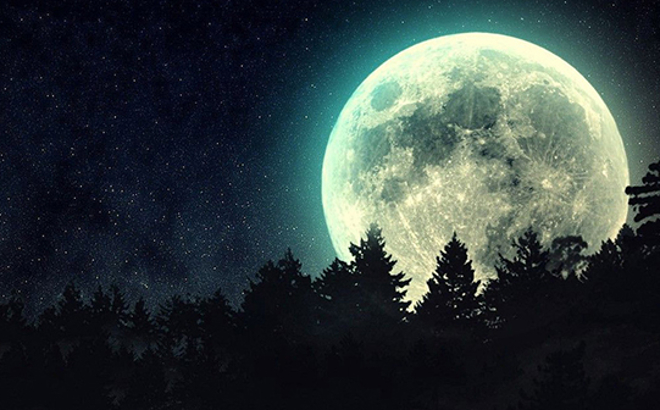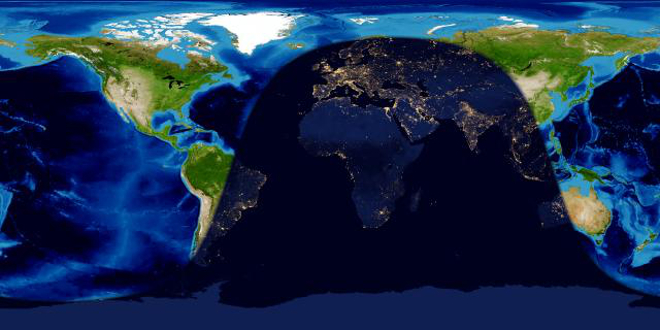|
Why no eclipse with tonight's full moon? |
|
May 10, 2017 |
 |
By Bruce McClure
EarthSky.org
Tonight – May 10 – the moon is full. Here’s
something fun about this May full moon, and, in
fact, about most full moons. That is, it won’t
undergo an eclipse. In fact, the May 10 full
moon swings a whopping five degrees (10 moon
diameters) north of the ecliptic, the plane of
Earth’s orbit around the sun.
So it misses being in Earth’s shadow by a wide
margin.
Some full moons come closer to passing through
Earth’s shadow – that is, closer to being in
eclipse without actually doing so – but the fact
is that most full moons fail to reside at the
antisolar point, the point that’s directly
opposite the sun.
It’s only when the moon passes through or very
close to the antisolar point that we see a total
eclipse of the moon.
Story continues below photo
 |
| Worldwide map
via Earthview, showing the day and night
sides of Earth at the instant of the May
full moon, May 10 at 2:42 p.m., Bonners
Ferry time. |
The next two full moons – June and July 2017 –
will pass to the north of the ecliptic and the
antisolar point, too. So there will be no lunar
eclipse in June or July 2017.
The August 2017 full moon will sweep less than
one degree north of the ecliptic. The relatively
close pass will bring the southern part of the
lunar disk into the northern part of the Earth’s
dark umbral shadow. So, if you’re on the right
place on Earth, you’ll see a partial lunar
eclipse on August 7, 2017.
It’ll come just two weeks before the
much-anticipated total solar eclipse of August
21, 2017, first total solar eclipse to be viewed
from the contiguous United States since 1979.
This May full moon is the second full moon after
the March equinox. In North America, we’ll call
it the Flower Moon, Planting Moon or Milk Moon.
Meanwhile, in the Southern Hemisphere, this full
moon is called the Beaver Moon or Frost Moon.
For general reference, we can say the moon is
full all night. But, technically speaking, the
moon is full only at the instant that it’s
180-degrees from the sun in ecliptic longitude.
The moon turns full on May 10 at 21:42 UTC (2:42
p.m. Bonners Ferry time).
For North America, the moon will turn exactly
full when the sun is above the horizon and the
moon is still below it.
Because the moon stays more or less opposite the
sun in our sky at the vicinity of full moon,
tonight’s moon will rise in the east around
sunset and climb highest up for the night around
midnight (midway between sunset and sunrise).
That’s true as seen from around the globe.
Then, around sunrise on May 11 – as seen from
around the world – the moon will set in the
west. |
|
Questions or comments about this
article?
Click here to e-mail! |
|
|
|
|

